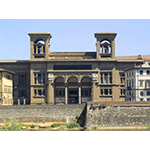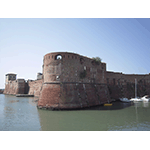Institutions linked to Galileo and places of commemoration
Pisa houses in its principal cultural institutions - those surviving from Galileo’s time and those founded subsequently (such as the University with its well-stocked Library, the National Archive and Galileo’s home) - a legacy of letters, original manuscripts and collections of mementos accumulated over the centuries, which make up a substantial part of the existing documents on Galileo.
The Galileo celebrations in Florence vary from the construction of monuments to the systematic collection of materials of historical and archival interest.
Some of the instruments which Galileo had given to the Medici, such as the telescope lens with which he carried out his numerous scientific observations between 1609 and 1610, were conserved in the Wardrobe of Prince and later Cardinal Leopoldo de’ Medici. At Leopoldo’s death these objects became part of the Medici collection, conserved in the Uffizi Gallery, where they remained until 1793, when they were transferred to Florence’s Museum of Physics and Natural History.
The peak of the Galileo celebrations occurred with the construction of a monumental framework called "Tribuna di Galileo" [Galileo’s Stand], inside the Museum of Physics and Natural History. The Tribuna was inaugurated in 1841 to honor the third Congress of Italian Scientists. The work consists of a rich array of frescoes and bas-reliefs portraying instruments, scientific discoveries and the scientists that made them possible. At the center of the Tribuna’s semi-circle is a statue of Galileo by Aristodemo Costoli, and displayed on either side of it are scientific instruments that belonged to him and to the Accademia del Cimento. In 1927 these instruments, including the only two surviving telescopes that Galileo constructed personally, were transferred to the Museum of the History of Science, founded through the initiative of the Univeristy of Florence. Even today, the Institute and Museum of the History of Science maintains a permanent exhibit of many original and precious instruments, mementos and several models made in the 18th and 19th centuries to illustrate Galileo’s key research on mechanics.
Strolling through Florence, one frequently runs into monuments dedicated to Galileo. A statue of him stands in the Uffizi Gallery courtyard, and another is on the front of the National Library, an institution which also houses the largest manuscript collection of Galileo’s works in the world. A bust of him can be glimpsed, though with some difficulty, given its distance from the ground, in the lower-lefthand corner of the cornice surrounding the main rose window of the nineteenth-century façade of the Duomo. The most recent and intriguing monument is Giò Pomodoro’s stela, entitled Sun for Galileo Galilei, inaugurated in September of 1997 in Piazza Poggi, on Lungarno Serristori.
Many objects celebrating Galileo are also to be found in Florence’s historic buildings. A portrait of Galileo dating from the 1620’s is on view in the Sala Verde, along the lefthand wall of the Officina Profumo Farmaceutica of Santa Maria Novella. At the Casa Buonarroti, in 1636, Francesco Montelatici, called Cecco Bravo, painted Galileo with his telescope and an open book showing the moon’s surface. In the west corridor of the Uffizi Gallery a sculpture of Galileo, commissioned by the Medici family, bears the title of "New Archimedes". At the entrance to the Institute and Museum of the History of Science sits an imposing marble bust sculpted in 1674 by Carlo Marcellini. In the Modern Art Gallery of Pitti Palace more scenes of Galileo are on display in the work of Luigi Catani, a painter from Prato, and at the Museo degli Argenti small putti raise up lenses, spyglasses and telescopes. Last but not least, a statue of Galileo stands in the Rectorate of the University of Florence.
Galileo’s name is celebrated in other Tuscan towns as well. In the 19th century he was the subject of a lyric opera by his name performed at the City Hall of Pistoia, and the philanthropist Niccolò Puccini, at his Scornio villa, designed a garden studded with monuments on scientific themes, among which Galileo’s hemicycle, still visible today though in fairly bad shape.
Galileo also did a lot of research in Leghorn. Between 1590 and 1592 Don Antonio de’ Medici (1576-1621) proposed a machine for emptying Leghorn’s dockyard, but Galileo - as Viviani reports in his Racconto istorico [Historical Account] - expressed a negative opinion of it. In 1617 Galileo was at the port to try out his "celatone", a device for using telescopes on ships even in rough waters. The Pisan lighthouse too was used as an observation point of the heavens. After Galileo’s death the Old Sangallo Fort was the scene, in 1662, of experiments on the movement of artillery shells carried out by academicians of Cimento to test out Galileo’s conclusions. In the mid-nineteenth century the merchant of French origin Francesco Giacome Larderel, who was the first to set up an industrial plant at Montecerboli for the production of borax, placed in the vestibule of his splendid villa statues of illustrious Tuscan figures, among which Galileo.
-
 Biblioteca Universitaria di Pisa - Palazzo della Sapienza [University Library of Pisa - Palazzo della Sapienza]
Biblioteca Universitaria di Pisa - Palazzo della Sapienza [University Library of Pisa - Palazzo della Sapienza]
-
 Archivio di Stato di Pisa [Pisa State Archive]
Archivio di Stato di Pisa [Pisa State Archive]
-
 Domus Galilæana
Domus Galilæana
-
 Galleria degli Uffizi [Uffizi Gallery]
Galleria degli Uffizi [Uffizi Gallery]
-
 Tribuna di Galileo
Tribuna di Galileo
-
 Museo Galileo - Istituto e Museo di Storia della Scienza [Institute and Museum of the History of Science]
Museo Galileo - Istituto e Museo di Storia della Scienza [Institute and Museum of the History of Science]
-
 The Uffizi Loggia
The Uffizi Loggia
-
 Biblioteca Nazionale Centrale di Firenze BNCF [Central National Library of Florence]
Biblioteca Nazionale Centrale di Firenze BNCF [Central National Library of Florence]
-
 Cathedral of Santa Maria del Fiore
Cathedral of Santa Maria del Fiore
-
 Stele 'Sole per Galileo Galilei' ['Sun for Galileo Galilei' Stele]
Stele 'Sole per Galileo Galilei' ['Sun for Galileo Galilei' Stele]
-
 Officina Profumo Farmaceutica di Santa Maria Novella [Perfume and Pharmaceutical Works of Santa Maria Novella]
Officina Profumo Farmaceutica di Santa Maria Novella [Perfume and Pharmaceutical Works of Santa Maria Novella]
-
 Casa Buonarroti [The Buonarroti House]
Casa Buonarroti [The Buonarroti House]
-
 Palazzo Pitti [The Pitti Palace]
Palazzo Pitti [The Pitti Palace]
-
 Museo degli Argenti [The 'Museo degli Argenti' (The Medici Treasury)]
Museo degli Argenti [The 'Museo degli Argenti' (The Medici Treasury)]
-
 Università degli Studi di Firenze - Rettorato [University of Florence - The Rectorate]
Università degli Studi di Firenze - Rettorato [University of Florence - The Rectorate]
-
 Palazzo Comunale di Pistoia [Town Hall of Pistoia]
Palazzo Comunale di Pistoia [Town Hall of Pistoia]
-
 Medici Port of Livorno
Medici Port of Livorno
-
 Fanale dei Pisani [The Pisans' Lighthouse]
Fanale dei Pisani [The Pisans' Lighthouse]
-
 Fortezza Vecchia di Livorno [Old Fortress of Livorno]
Fortezza Vecchia di Livorno [Old Fortress of Livorno]
-
 Palazzo De Larderel
Palazzo De Larderel
-
 Galleria degli Uffizi - Stanzino delle Matematiche [Uffizi Gallery - Stanzino delle Matematiche]
Galleria degli Uffizi - Stanzino delle Matematiche [Uffizi Gallery - Stanzino delle Matematiche]
****************************
Texts by Sara Bonechi
English translation by Edward Tosques
Last update 08/lug/2008





